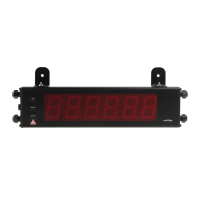
Do you have a question about the red lion LD Series and is the answer not in the manual?
| Backlight | LED |
|---|---|
| Contrast Ratio | 500:1 |
| Display Size | 15 inch |
| Operating Temperature | 0°C to 50°C |
| Communication | Ethernet |
| Protocols | Modbus |
| Enclosure | NEMA 4X |
| Viewing Angle | Horizontal: 140°, Vertical: 120° |
| Storage Temperature | -20°C to 60°C |
Details on LED display type, intensity, and power requirements.
Specifications for input ranges, accuracy, and bridge excitation.
Programmable inputs, totalizer functions, RS485/RS232 communications.
Operating conditions, enclosure type, weight, and certifications.
Guidelines for location, mounting, and cleaning the unit.
Setting jumpers for input range, excitation, and input type.
Ensuring EMI compatibility and details on terminal blocks/cord grips.
Connecting terminal blocks for power, signals, and user inputs.
Wiring the setpoint relays using terminal block TBB.
Connecting for RS232 and RS485 serial communications.
Key functions for display mode and programming mode operations.
Understanding Full/Quick modes, programming tips, and factory settings.
Guide for entering, navigating, and setting parameters.
Configuring input range, decimal point, and display rounding.
Setting input filter and defining scaling points/style.
Entering input and display values for scaling points.
Programming user inputs and front panel keys for specific functions.
Locking programming and zeroing the display value.
Relative/Absolute display, Hold, Zero Display, Totalizer batching.
Resetting, enabling totalizer, and controlling max/min displays.
Configuring setpoints and requesting printouts.
Locking displays and configuring setpoint access.
Managing security codes and access to programming modes.
Configuring capture delays, display update, and auto-zero tracking.
Setting display offset value and unit label backlight.
Setting totalizer decimal point and time base for accumulation.
Configuring totalizer scale, low cut value, and batch operations.
Choosing setpoints, defining actions, and setting alarm values.
Configuring hysteresis, delays, and output logic for alarms.
Setting alarm values, sources, and hysteresis.
Configuring delays, logic, resets, and alternate setpoints.
Configuring serial settings: baud, data bits, parity, and meter address.
Selecting print format and which values to include in prints.
Details on command format, numeric data, and response modes.
Description of full field and abbreviated transmissions.
Controlling setpoint outputs and reading their status via CSR.
Understanding timing for commands and data transmission.
Voltage levels and data framing for serial communication.
Adjusting display intensity and restoring factory settings.
Steps for performing input calibration of the meter.
